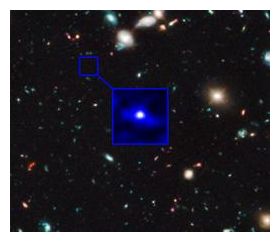
Astronomers have glimpsed the most distant galaxy ever detected - a lone object 13.2 billion light years from Earth. The discovery implies that the fledgling Universe was emptier than was previously imagined.
The galaxy was spotted in the Hubble Ultra Deep Field, an infrared image of the night sky that contains the faintest and farthest objects so far pictured. The finding "pushes the data to the very limits", says Rychard Bouwens, an astronomer now at Leiden University in the Netherlands and a co-author of the study, which is published today in Nature.1
Bouwens and his colleagues determined the distance to this galaxy using 'redshift' measurements. As the Universe expands and objects in it move apart, observers perceive light travelling from far-flung sources as stretched to longer wavelengths - that is, towards the red end of the electromagnetic spectrum. The further away something is, the faster it recedes, and the more the light is stretched.
Bouwens's team looked for objects whose light has been redshifted out of the optical portion of the spectrum and into the infrared. The primordial galaxy that they found is so remote that its light is detectable only at the longest infrared wavelengths that Hubble can see.
Because of its distance, we see this galaxy as it existed at an early era of the Universe - about 480 million years after the Big Bang. This period is at the edge of Hubble's observational limits, but models suggest that the telescope should have detected several galaxies from the same time period instead of one, says Bouwens.
The near-barrenness of this epoch stands in contrast to a period roughly 650 million years after the Big Bang, in which the team has found around 60 galaxies.
Cosmic blink
The results suggest that in fewer than 200 million years - a cosmic blink of an eye - large galaxies rapidly built up from smaller ones, and the rate of star formation increased tenfold. "It's telling us that there is a very dramatic change taking place at this time period," says Garth Illingworth, an astronomer at the University of California, Santa Cruz, and a co-author of the paper.
The sparseness of galaxies raises a mystery. Around this period, ultraviolet radiation split much of the neutral hydrogen in the Universe into its constituent protons and neutrons, a process called reionization. If this hadn't happened, we would be able to view much less of the Universe than we can, because neutral hydrogen is effective at absorbing many wavelengths of light, says Bouwens.
If the team's finding is correct, there could not have been enough stars around to generate the levels of ultraviolet radiation needed for reionization, says Illingworth. Other sources, such as active galactic nuclei - compact regions at the centres of galaxy that shine brightly in some or all regions of the electromagnetic spectrum - could have provided the extra radiation. But they receive their energy from super-massive black holes that would probably not have had enough time to form in this era, says Bouwens.
"I think this is a great result," says Rogier Windhorst, an astronomer at Arizona State University in Tempe who was not involved in the work, adding that it gives a glimpse of what astronomers can expect to see with Hubble's yet-to-be-launched successor, the James Webb Space Telescope (JWST).
Pushing limits
Hubble data can't confirm such large redshift findings in shorter wavelengths, so other researchers have avoided the method, says James Dunlop, an astronomer at the University of Edinburgh, UK. "It's pushing the data to a limit for which it wasn't designed," he says. Dunlop is sceptical that the redshift of the distant galaxy is as high as reported, saying that noise could be interfering with the results.
There is also evidence that there were more galaxies during this era than the team has found. Using the same Hubble data, another team detected tens of potential galaxies at the same redshift, suggesting that the increase in the number of galaxies between 480 million and 650 million years after the Universe was born was slower than is implied by Bouwens and his colleagues.2
Another analysis, which uses the rate of rare supernova explosions called γ-ray bursts to determine the rate of star formation in the early Universe, also favours a greater number of galaxies at this time period.3 "I believe that they're not finding all of the stars out there," says John Beacom, an astronomer at Ohio State University in Columbus and a co-author of the γ-ray burst study.
Further observations with Hubble and the JWST will be needed to clear up these discrepancies, says Bouwens. "We'll get more data," he says. "I don't think this will be the last word."
References
- Bouwens, R. J. et al. Nature 469, 504-507 (2011).
- Yan, H.-J. et al. Res. Astron. Astrophys. 10, 867-904 (2010).
- Kistler, M. D. , Yüksel, H. , Beacom, J. F. , Hopkins, A. M. & Wyithe, J. S. B. Astrophys. J. 705, L104-L108 (2009).



maybe not
[Link][Link][Link]